Elixir is a vibrant and well-designed language for developing scalable and maintainable software applications. It is well known to leverage the Erlang VM which runs a low-latency, distributed and fault-tolerant systems. It is widely used for building web-based applications and the embedded software-based systems. Elixir Programming language has the following features.
-
- Scalability − Elixir based applications are executed inside lightweight processes which are isolated and where the information is exchanged through messages.
- Fault Tolerance − Elixir has one of the best fault tolerant systems where supervisors in Elixir help to describe how to take actions in case of failure to make sure that the recovery from failure is guaranteed.
- Functional Programming – It is a well-designed programming language that promotes a coding style to enable developers to write short, fast, and maintainable code.
- Build tools − Elixir supplies a set of development tools in its package. E.g. Mix is one of such tool that helps in the projects creation, tasks management, tests execution, etc. Hex, a project management tool is another example.
- Erlang Compatibility − Elixir code executes on the Erlang VM which provides developers the complete access to Erlang’s ecosystem.
Environment Setup
Elixir based program executes on Erlang VM. Therefore, it is required to have Erlang on your local machine. Some platform supplies Elixir package along with Erlang. Given below is the link through which Elixir can be downloaded.
|
Elixir Download |
|
https://elixir-lang.org/install.html |
Installing Elixir on Windows
Elixir is available for different Operating Systems such as Windows, Linux, Mac, etc. In this article, we are going to use below link in order to download installer for Elixir installation on Windows operating system.
|
Elixir Download |
|
https://elixir-lang.org/install.html#windows |
STEP 1: After installer has downloaded successfully, click on the exe file. It will open the dialogue box shown below. Click on Next button.

STEP 2: It will display various Elixir versions. We need to choose one version out of the displayed list. We are going to choose the latest version i.e. Elixir version 1.6.5 and click on Next button.
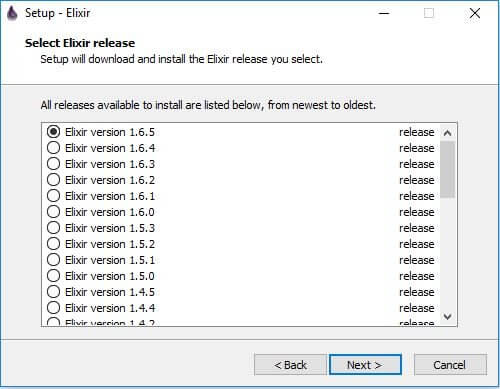
STEP 3: Next, we need to select Additional task to install Erlang. As discussed earlier that Erlang VM must to present on the local machine in order execute Elixir code. This step will install Erlang OTP 20.2 (64-bit). Choose this option and click on the Next button.

STEP 4: Installer will take couple of minutes to download additional files and complete installation of Elixir and Erlang on the local machine.
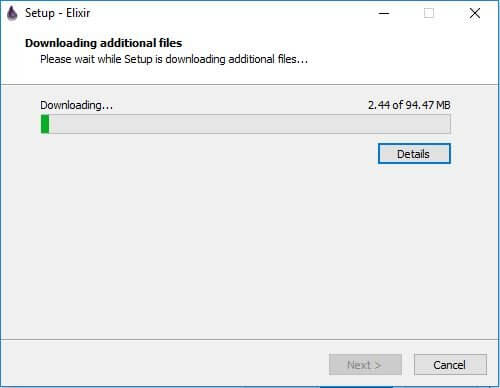
STEP 5: Next, click on the Next button after choosing the components as shown below.
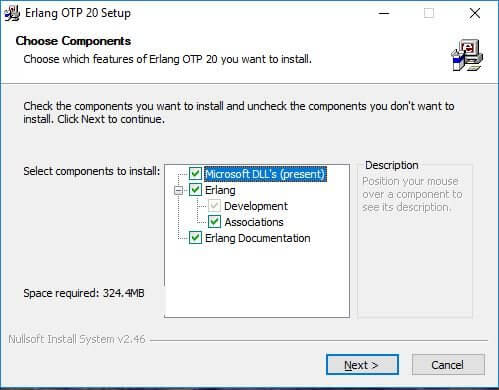
STEP 6: Next, choose the local installation path in order to setup and install Erlang OTP 20 as shown below. Click next to proceed with the installation.

STEP 7: Click on the close button to complete the installation setup as shown below.
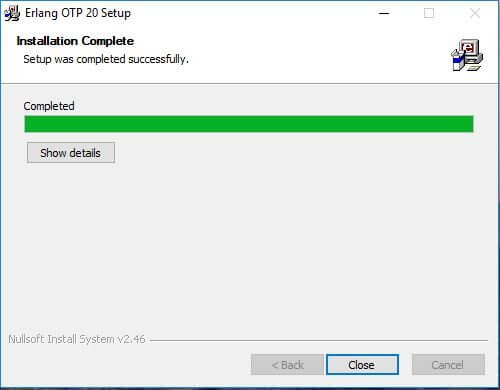
STEP 8: Now, lets test if Elixir setup has successfully installed on our system. We need to open a terminal on windows and enter iex on it. If the installation was successful, then it will open up the interactive elixir shell as shown below.

Elixir Programming Language – Basic Syntax and rules
In this article, we are going to use the Elixir script mode where we can save the Elixir code into a file with the extension “. ex”.
- A basic example to print string
STEP 1: Let’s us keep the simple code to print string “Hello Elixir” into the “test_elixir. ex” file as shown below.
|
test_elixir. ex |
|
IO.puts “Hello Elixir” |
STEP 2: Now, we will execute the code present in above file in the terminal as shown below. It will print the string.
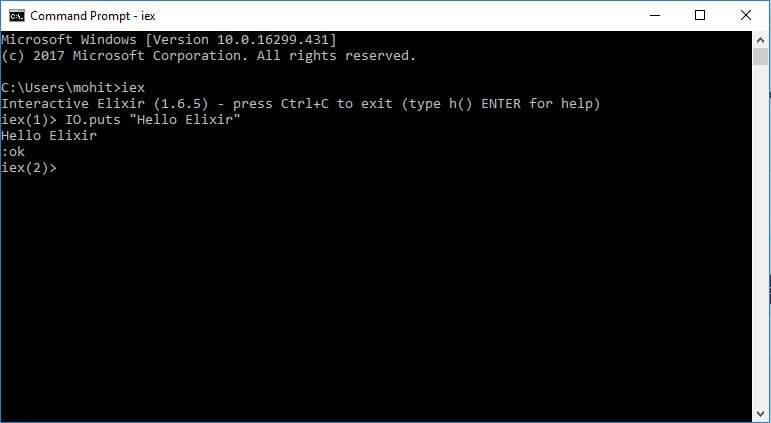
Comments: When the developer wants to enter texts in the program and don’t want that part of code to compile and execute such lines of code are known as comments. Single line comments in Elixir programming language start with a ‘#’ symbol. It does not support multi-line comment, but we can stack multiple comments. For example,
|
Comments |
|
#This is how we provide comment in Elixir |
- Line Endings: We can place multiple statements in the same line by simply using ‘;’. In Elixir, there are no required line endings like ‘;’. For example,
|
Comments |
|
IO.puts (“Hello”); IO.puts(“Elixir!”) |
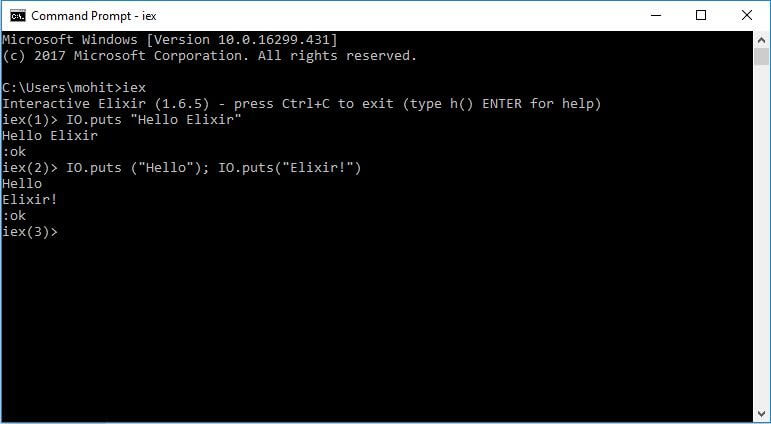
- Identifiers: In Elixir, identifiers such as variables, function names are used to identify a variable, function, etc. respectively. We can name our identifiers starting with a lower case alphabet, followed by numbers, underscores and upper case letters subsequently. It has naming convention which is commonly known as snake_case. The following are some of the valid identifiers examples used in Elixir.
|
Identifiers |
|
variable1 var_2 one_N0r3_var |
This should be noted that in Elixir, we can also name variables with a leading underscore. Any value which is not meant to be used must be assigned to _ or to a variable which starts with underscore. Example is shown below.
|
Identifiers |
|
_any_random_val = 42 |
Also, elixir programming language relies on underscores in order to make functions private to the modules. If we name any function with a leading underscore in a module and import that module, then this function will not be imported since it has made private with the use of leading underscore.
- Reserved Words: The following are the reserved words in Elixir which cannot be used as variables, module or function names.
|
Reserved Words |
|
after and catch do inbits inlist nil else end not or false fn in rescue true when xor __MODULE__ __FILE__ __DIR__ __ENV__ __CALLER__ |
Conclusion
In this article, we discussed about Elixir programming language and its dependency on Erlang VM. We have demonstrated various steps to install Elixir and Erlang on windows machine and further discussed on Elixir basic syntax and rules along with suitable examples.



